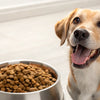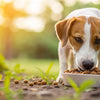Is Cat Kibble Bad for Dogs? Understanding the Implications of Canine Cat Food Consumption
- Houndsy
Table of Contents
- Introduction
- The Nutritional Differences: Cat Food vs. Dog Food
- When Is Cat Food Bad for Dogs?
- What to Do If Your Dog Eats Cat Food
- Tips for Preventing Dogs from Eating Cat Food
- Conclusion
Introduction
Have you ever witnessed the comical scene of your dog sneaking a bite from the cat’s bowl, only to be met with a look of indignation from the feline? If you have pets in your home, this scenario may feel all too familiar. But have you ever stopped to ask yourself, is cat kibble bad for dogs?
The curiosity surrounding this issue is not just about the humorous antics of our pets; it reflects a genuine concern for their health and well-being. According to a study published by the American Veterinary Medical Association, a significant number of pet owners have reported their dogs eating cat food at some point. This raises a critical question: is it safe for our dogs to indulge in cat kibble, and what are the potential consequences of doing so?
In this blog post, we will explore the nutritional differences between cat and dog food, the implications of feeding cat kibble to dogs, and tips for managing multi-pet households. By the end, you will have a comprehensive understanding of why it is generally not recommended to feed cat food to dogs, ensuring that your furry friends remain happy and healthy.
The Nutritional Differences: Cat Food vs. Dog Food
Understanding the fundamental differences between cat and dog food is crucial for any pet owner. While both types of food may appear similar and even contain some of the same ingredients, the nutritional requirements for dogs and cats are vastly different.
1. Nutritional Composition
Cats are obligate carnivores, meaning they require a diet primarily composed of meat. This dietary necessity leads cat food to be higher in protein and fat compared to dog food. On the other hand, dogs are omnivores, meaning they can thrive on a varied diet that includes both animal and plant-based foods. Here’s a breakdown of the AAFCO (Association of American Feed Control Officials) minimum nutrient requirements for adult dogs and cats:
| Nutrient | Adult Dogs (Minimum) | Adult Cats (Minimum) |
|---|---|---|
| Protein | 18% | 26% |
| Fat | 5.5% | 9% |
| Taurine | 0 | 0.1% (dry), 0.2% (canned) |
| Arachidonic Acid | 0 | 0.02% |
| Vitamin A | 5,000 IU/kg | 3,332 IU/kg |
As you can see, cat food is specifically formulated to meet the higher protein and fat needs of cats, which can be detrimental to dogs if consumed regularly.
2. Implications of Feeding Cat Food to Dogs
While an occasional nibble of cat food might not cause immediate harm to most dogs, it is crucial to understand the potential long-term consequences of regular consumption:
- Gastrointestinal Upset: Dogs that eat cat food may experience gastrointestinal issues due to the high protein and fat content. Symptoms can include vomiting, diarrhea, and abdominal discomfort.
- Weight Gain and Obesity: The calorie density of cat food can lead to weight gain in dogs. Over time, this can result in obesity, which can exacerbate other health issues.
- Pancreatitis Risk: High-fat diets, such as cat food, can lead to pancreatitis in dogs, a serious condition that requires immediate veterinary attention.
- Nutritional Imbalances: Relying on cat food can result in nutritional imbalances for dogs, as they may miss out on essential nutrients that are tailored to their dietary needs.
When Is Cat Food Bad for Dogs?
Understanding when cat food can be harmful to dogs is essential for pet owners. Here are specific scenarios when feeding cat food can lead to health issues:
1. Regular Consumption
If your dog is consistently eating cat food, they are likely consuming too much protein and fat. Long-term exposure to these levels can result in obesity and pancreatitis, among other health complications.
2. Specific Health Conditions
Certain dogs should avoid cat food altogether, especially if they have pre-existing health conditions such as:
- Pancreatitis: Dogs prone to this condition should avoid high-fat diets at all costs.
- Kidney or Liver Disease: Dogs with these conditions require moderate protein levels, which cat food does not provide.
- Sensitive Stomachs: If your dog has a history of gastrointestinal issues, cat food could trigger uncomfortable symptoms.
3. Puppies
Puppies have specific nutritional needs for proper growth and development. Feeding them cat food can lead to rapid weight gain and developmental issues due to the imbalanced nutrient profile.
What to Do If Your Dog Eats Cat Food
If your dog manages to sneak a substantial amount of cat food, it’s important to monitor their behavior closely. Here’s a step-by-step guide on what to do:
- Assess the Situation: Determine how much cat food your dog has consumed. A small amount might not require immediate action, but a large quantity warrants attention.
- Monitor for Symptoms: Watch for signs of gastrointestinal upset, such as vomiting or diarrhea, as well as signs of lethargy or abdominal pain.
- Consult Your Veterinarian: If symptoms persist or if your dog appears unwell, contact your veterinarian for guidance. They may recommend dietary adjustments or other interventions.
Tips for Preventing Dogs from Eating Cat Food
Managing a multi-pet household can be challenging, especially when it comes to feeding. Here are some tips to keep your dog out of the cat's food:
1. Separate Feeding Areas
Designate specific feeding areas for your cat and dog. Use baby gates or crates to create barriers, ensuring that each pet can have their meal without interference.
2. Elevated Feeding Stations
Consider feeding your cat in elevated spots that are out of reach for your dog. Cat trees or high countertops can serve as ideal feeding locations.
3. Use of Creep Feeders
Invest in a creep feeder, which allows only your cat to access the food while keeping your dog at bay.
4. Training Commands
Teach your dog the “leave it” command. This can be helpful not just for cat food but for managing other tempting situations as well.
Conclusion
So, is cat kibble bad for dogs? The answer is complex but clear: while a small amount of cat food may not harm healthy dogs, regular consumption can lead to serious health problems. The distinct nutritional differences between cat and dog food mean that dogs require a balanced diet specifically formulated for their needs.
As responsible pet owners, it’s our duty to ensure that our furry companions receive the proper nutrition they deserve. By understanding these differences and implementing strategies to manage our multi-pet households, we can create a safe and healthy environment for all our pets.
If you’re looking to simplify your dog’s feeding experience and enhance mealtime rituals, consider exploring the Houndsy Kibble Dispenser. This innovative product not only provides perfect portions but also complements your home decor with its stylish design. Let’s make feeding time a joy for both you and your pets!
FAQ
Q: Can dogs eat cat food occasionally?
A: Yes, a small amount of cat food on rare occasions is generally safe for dogs. However, it should not be a regular part of their diet.
Q: What should I do if my dog eats cat food?
A: Monitor your dog for any signs of gastrointestinal upset. If symptoms persist or if your dog appears unwell, contact your veterinarian.
Q: Is cat food toxic to dogs?
A: No, cat food is not toxic to dogs, but it is not nutritionally suitable for them and can lead to health issues if consumed regularly.
Q: How can I keep my dog away from cat food?
A: Use separate feeding areas, elevated feeding stations, and training commands to prevent your dog from accessing cat food.
Q: What are the signs of pancreatitis in dogs?
A: Symptoms of pancreatitis may include vomiting, lethargy, abdominal pain, and a hunched back. If you suspect your dog has pancreatitis, seek immediate veterinary care.













